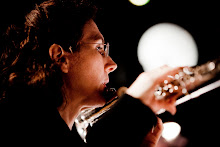Be that as it may, I got a good dose of inspiration. He began Sunday morning chatting about singing and playing, and the importance of singing in general. There's nothing like it to get you listening. He said that if he were to teach a beginner, he would start with singing. This resonates with what I have been thinking these years, esp. after having studied in India. There, one learns to sing or use the voice first, even in training to be a percussionist! I think we are a strange musical culture, that puts some object into a kid's hand and says, now make music out of it! Someday, I must put my India notes on blog.
Anyhow, back to Robert.
5 of our (Harrie Starreveld's and my) students, past and present, took part. I was very impressed with what Robert had to say about Mozart and Kuhlau. This was the first time I had heard him coach the classical and romantic repertoire; his keen musicality and vivid imagination made for very good lessons.

We did touch on learning harmonic multiphonics, in the context of Fukushima's Mei. This applies to Berio Sequenza as well. [The 1st days of the masterclass went into extended techniques in detail - I unfortunately missed them.] When it comes to the harmonic multiphonics that are found in these two pieces, it pays to put in some serious time in studying them before learning the piece. You don't learn the sonority in the piece, just like you don't learn the D major scale by playing Mozart!
He described it thus: by not practicing the sonorities first and just hoping they come in the concert - it is as if you walk down to the sea and just happen to reach in the water and pick out the exact fish you wanted!
How to go about preparing harmonic multiphonics:
Practice octaves, fifths, and fourths - in that order.
With octaves, it is easiest to begin where the flute has a short tube: C2 - C3. then work your way down.

With fifths and fourths, begin where the flute is longest, low C or B and work your way up.
Suggested practice time devoted to this: 15 min each day.
The benefit of this is not only to learn these sonorities, but to make the lips fit. If it's worth doing, it's worth doing well. This is the practice pathway up the mountain!



I really enjoyed reading your blog. It was a great reminder for me since I usually only practice my octave harmonic multiphonics. So, I found this extremely helpful because it reminded me that I do need to constantly work on expanding my practice and to the include the fourth and fifth harmonic multiphonics.
ReplyDelete